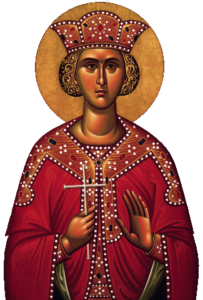
I’ll try to keep this short. This is Thanksgiving week. You probably don’t have much time to read, and I don’t have much time to write, because all our family will soon be here.
_______________________________________
Feminine Weakness?
Occasionally in our Orthodox hymns for certain female martyrs, we give thanks that they bravely overcame their “feminine weakness”. * When I was chanting, I sang such phrases quietly with my fingers crossed or sometimes (I now confess) I omitted those words entirely.
- none of which hymns I can locate just now
Feminine weakness? Really? OK, granted, few women have the physical strength of The Hulk, but is that the kind of strength we admire here? It doesn’t require gigantic shoulders to resist tyrants, to endure torture, and to die faithful to Christ to the end. Surely God is concerned with strength of will, determination, steadfastness, faithfulness. In my experience, most women have those virtues in abundance. “Feminine weakness”? Nonsense.
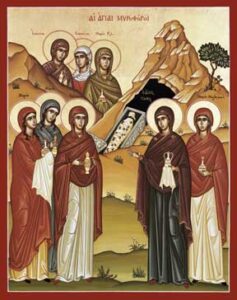
Feminine weakness? Some years ago, our late Antiochian Metropolitan Philip (may his memory be eternal) sent me as his delegate to a national Convention of the Episcopal Church, from whence I had come. I was preparing to be disparaged because we Orthodox “hate and oppress women”, inasmuch as we don’t ordain them. I always feel very awkward about this. (“I believe women can have any job they want – except mine.“) At the time I was our clergy representative to the Orthodox Christian Women’s Association of Milwaukee – who, by the way, were one of the most capable and competent group of people I have ever dealt with anywhere. So after one of their business meetings I, rather hesitantly, asked them: “Do you have any problem that the Orthodox Church doesn’t ordain women?” Almost before I could get the question out of my mouth, they all very firmly said “No!” “Why not?” I asked. The first answer: “Why should we want to be priests? We already run the Church!”
Feminine weakness? Years ago, an Episcopalian Bishop whom I knew had taken an apartment in a New York building where the clientele were chiefly conservative Jews. He said the people he became acquainted with were very firm that the man was the head of the family, but that as he got to know them better he came to understand how the system worked. Here is how he described it: “The man was the head of the family, and the woman made all the decisions!”
Feminine weakness? Somewhere I read of a Greek village woman who described it like this: “The man is the head. The woman is the neck.”
Femine weakness? There are a few weak women. I dated a couple. They bored me to death. I fell in love with and married a strong woman, and I’ve been glad for it every day of our 55 1/2 year marriage. (OK, almost every day…)
Feminine weakness? As for Orthodox Church women, we all know that with rare exception they are strong, steady, bright, know what they’re doing, and they get it done. As our Antiochian Bishop Nicholas wrote: “Women, as the Church emphasizes, are the backbone of the Church in that they are the backbone in their respective parishes and homes.”
All this is by way of introduction to one particular strong, brilliant, steadfast and beautiful young woman. Here is her story as it has been handed down to us.
But before we begin, let’s clear up one thing. The Roman Catholic Church has “demoted” Katherine, on the grounds that there is not sufficient documentary evidence about her. (They’ve done the same to Saint Nicholas.) I agree it’s very important that we not get caught up in myths. However, I think the RC approach is mistaken. In cultures where few can read and write, people retain information by memory and can pass it down almost unchanged from generation to generation. * Therefore, without insisting on every detail, in general I trust the Church’s story about Katherine.
- Today, on the other hand, we have documentary evidence about almost everything, and many people believe scarcely a word of it!
So… here’s the story as handed down to us:
The Holy And Wise Great Martyr Katherine of Alexandria

In the Fourth Century AD, Alexandria, Egypt, was one of the great cities of the world, a center of trade, culture, education and religion. This is why Saint Katherine’s story became so well known. As we continue, please remember that many Christian women through history have had the same character as Katherine, and many have been martyred, but are unknown to us chiefly because they lived in smaller or more out of the way places.
During the early Fourth Century Katherine was the daughter of Constas, the governor of Alexandria during the reign ot the militantly anti-Christian Emperor Maximian, or some say under his successor Maxentius, who was worse. *
- He had broken his pact with the Emperor Constantine the Great that he would tolerate Christians. Instead he continued the persecution till 312 when Constantine defeated him.
Katherine was both beautiful and brilliant. Contrary to the plight of most women of the time, she received an excellent education, studying the works of the great philosophers. Many wanted to marry her, but she refused them. She told her parents she would marry only a man who surpassed her in wisdom, wealth and looks. Such a man would obviously be nearly impossible to find.
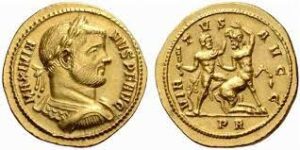
Katherine’s mother Empress Augusta, a secret Christian, told her daughter about the Christian Faith. Her mother’s spiritual father was an ascetic who lived in a cave outside the city, so she sent her daughter to him for advice about the matter. The elder told her he knew of a Man who surpassed her in every way. Intrigued, she asked if she could see Him. Yes, said the Elder, who gave her an icon of The Theotokos with the Man in His infancy held on her lap. He told Katherine to pray to the Mother of God to allow her to see her Son.
Katherine did so earnestly that night, and in a dream she saw the Holy Virgin, who was telling her Son how beautiful and wise Katherine was. Christ replied: She is not beautiful or wise in My sight.
Katherine returned to the Elder deeply saddened and told him what she had seen. He lovingly explained that what was missing in her life was Holy Baptism and faith in the Son Jesus Christ. So Katherine accepted Baptism from him. Again that night in a dream Katherine saw the Theotokos and her Son who put a ring (a wedding ring) on her finger. When she woke next morning, there was indeed a ring on her finger! (What happened to that ring I don’t know.)
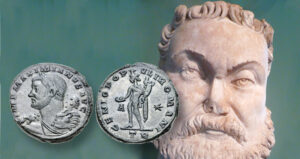
Soon after that the Emperor came to town for a pagan festival of some sort. (Kings and emperors often traveled around a lot in the old days.) The city was crowded and splendidly decorated for the feast, noisy with the cries of animals being sacrificed – and also of Christians who were being publicly executed.
Katherine, now feeling enormous sympathy for the Christian martyrs, went to the Emperor, confessed that she was a Christian, and begged him to stop the slaughter. Did she perhaps believe her position as the governor’s daughter would keep her safe? It did not, at least not for long.
Knowing her position and captivated by her beauty, the Emperor did not want her to die. He decided the way to avoid this was to convince Katherine of the superiority of pagan wisdom. He ordered a large number (some say fifty) of the most learned philosophers and orators he could find in order to win her back to paganism. However remember Katherine had studied philosophy. She got the better of them. I wonder if perhaps they, being wise, already had Christian sympathies. In any event, she refuted their every argument. In the end they accepted Christ. The Emperor was so furious that, to their horror, he had them burnt alive.
The Emperor now tried to win Katherine over by offering her great wealth and honor. When she refused that, he turned to torture. She remained unmoved, so he put her in prison. The Empress Augusta went to visit her and was so moved by Katherine’s steadfastness and the divine grace that shone forth from her, that she confessed to her husband that she was a Christian, and he had her executed. Well, what else could he do? He was now backed into a corner. This was profoundly embarrassing: his own wife a Christian! and if he pardoned her, then he would have to back down and set Katherine free – for all the world to see.
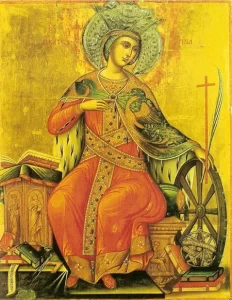
The next day, they again brought Katherine out to the judgment court under the threat of being broken on the wheel. * But as they began this torture, the wheel broke and she was set free.
- I long thought this wheel must have been a myth – till I looked it up. “The breaking wheel or execution wheel, also known as the Wheel of Catherine …, was a torture method used for public execution… from antiquity through the Middle Ages into the early modern period by breaking the bones of a criminal or bludgeoning them to death.” Wikipedia
The Emperor tried one more trick. Since Empress Augusta was dead, he offered Katherine the highest honor he had: “Will you marry me?” Imagine the life of honor and luxury she might have had. Katherine again refused. (I think being married to this rat even under ordinary circumstances would have been worse than death.) The Emperor was at his wit’s end, so he gave up and had Katherine beheaded. It was November 25 * in about the year 305 if it was Maximian, or later if it was Maxentius. Probably she was in her late teens or early twenties.
- In Russia her martyrdom is commemorated on November 24. I’ve read good arguments for either date.
In the Orthodox Church she is also called “the Great Martyr Katherine”. The title “Great Martyr” is given to those who have resisted great and excruciating tortures and after their death have brought great numbers of people to the Christian Faith.
That is exactly what Katherine did and continues to do. Her body was taken (some accounts say miraculously) to a safe place on Mount Sinai (where Moses had received the Ten Commandments) far to the east of Alexandria in the Sinai Peninsula. Mount Sinai was in such a desolate and inaccessible place that over the years the exact location of her burial place was forgotten.
Saint Katherine’s Monastery
In the year 549 the Emperor Justinian founded a monastery at Sinai and ordered a church be built in honor of the Transfiguration of Christ. 400 years or so after that, monks of the monastery found Katherine’s tomb and brought her relics to the monastery. How did they know it was Saint Katherine? One story says a desert monk told them. Or perhaps because the story of the transfer of her body to Sinai was remembered – and who else would have been so carefully buried in such an isolated place? Most likely, because her relics exuded a sweet fragrance, which continues to this day.

The monastery at Sinai was in time renamed the “Sacred Autonomous Royal Monastery of Saint Katherine of the Holy and God-Trodden Mount Sinai”. “Autonomos” means that, though it is under the jurisdiction of the Greek Orthodox Church, it is otherwise independent: “The Church of Sinai”.
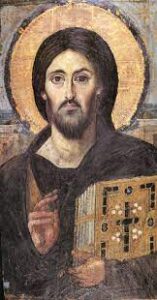
It is the oldest continuously inhabited Christian monastery in the world, holds the oldest continually operating library in the world (!) and also preserves some of the most ancient icons in the world, because it was untouched both by Christian Iconoclasts and by Islamic radicals. In 2002 it was named a UNESCO World Heritage Site. Today it receives a steady stream of pilgrims making the long trek out into the desert, each of whom is given a ring in memory of Saint Katherine.
Below: the relics of Saint Katherine of Alexandria


Here are two sites from the Monastery:
https://www.mountsinaimonastery.org/news-blog/2015/11/21/bride-of-christ-st-catherine-of-alexandria-november-25
https://www.mountsinaimonastery.org/
Commemoration of Saint Katherine out in the world
Over the centuries devotion to Katherine continued to flow out from Sinai – at first throughout the East. In the West this began when in 1027 a monk Simeon traveled through Europe, seeking money to preserve the Sinai Monastery (which was languishing behind the “Muslim curtain”), carrying some relics of Saint Katherine with him. There were miracles. Also, some of the Crusaders brought relics of Saint Katherine home with them. *
- This was how Saint George, a Palestinian martyr, became the patron saint of England, of all places.

During the 12th century when Orthodoxy in the East was weak, the Roman Catholic Order of the Knights of Saint Katherine was founded to protect the Monastery and those therein from the Bedouin Arabs. (The Crusades did much harm, but also some good.) The Philosophical School of Paris proclaimed Katherine as Patroness of Philosophical Studies. She was celebrated all over Europe as Patroness of Letters. Often she has been portrayed in art. (Be sure not to confuse her with Saint Catherine of Siena, a 14th Century Italian saint.)
Today churches – Orthodox, Roman Catholic and even a few Anglican – are dedicated to Saint Katherine of Alexandria all over the world, including many in the United States and Canada – and you know how many girls are named after her.
And that is the story of Saint Katherine of Alexandria – a model and inspiration and aid to all the strong, wise Christian women with which the Orthodox Church and indeed all the world are blessed.
_________________________________
Did I keep this short as promised? Well… no. I tried, but this was such a fascinating topic. And besides, I have “Blogger’s Disease”.
Next Week: How Saint Nicholas made me Orthodox and started a church in Wisconsin
Week after Next: Saint Ambrose of Milan
The story of St. Katherine is remarkable. So many of the early Christians demonstrated courage in the face of huge trials, and they put to shame the kvetching of so many today at least here in America (elsewhere in the world it’s another matter, of course). I think of her, St. George, and so many others, whenever people start worrying about repression, and pray we could be as resolute and faithful.
On the monastery: St. Katherine’s Monastery was so venerated and valued by the local Bedouin that it is said Mohammed himself sealed an order of protection for it (the original document is still preserved, albeit in Turkey since the 19th century, and bears Mohammed’s thumbprint). To this day, the local Muslim Bedouin honor it – I’m not sure even the most radicalized ISIS fighters would dare attack it. The government of Egypt, though, perhaps in an effort to “develop” the region, is building a highway to it, which will likely drastically reduce the isolation of the monastery, and the deliberate effort needed to make a pilgrimage. There is much concern that this could overly commercialize it all.
Thanks, Skip, for the information about the Saint Katherine’s Monastery, which I did not know, and now wish I didn’t: I’m trying not to imagine motels and restaurants and parking lots outside the Monastery.
The word “kvetch”, for any who don’t know, is Yiddish. It means to complain a lot. I agree with you: When Christians in America complain about how they are being repressed, all that means is they don’t know much about Church history.